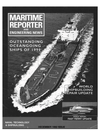
Page 36: of Maritime Reporter Magazine (December 1992)
Read this page in Pdf, Flash or Html5 edition of December 1992 Maritime Reporter Magazine
The "Vindile" features MTU propulsion
European Fast Ferry Market Is Picking Up Speed
By Marcus Gibson, journalist
The long-awaited scramble for big fast ferries from Europe's operators has begun.
More ships have been ordered or become the subject of bids over the past month (October) than in the rest of 1992. The recent drive is certain to make 1994 the year when the fast ferry comes of age.
Fast ferry developments on the western Channel routes have never been brisker.
The Weymouth-based company
Condor has bought a new $15 mil- lion, 74-meter long SeaCat from the
Tasmania, Australia, yard of Inter- national Catamarans. Delivery is scheduled for February 1993. A second SeaCat is on order but the company has also announced that it will lease a second SeaCat from Sea
Containers until it arrives.
Condor has also expressed an in- terest in purchasing an uprated 87- meter SeaCat design, able to carry 800 passengers and 170 cars.
How is Condor, a medium-sized fast ferry company with routes from
Weymouth to the Channel Islands and St. Malo in France, able to fi- nance the newbuildings?
Fifty percent of the shares in Con- dor have been purchased by Austra- lian transport giant, TNT, a com- pany which employs 50,000 world- wide.
Analysts say TNT bought Condor as a springboard to greater things, not merely its Channel Island li- censes. "The routes with the fastest growth potential are all in the west- ern Channel," said Alan Blunden, editor of Fast Ferry International.
The lucrative Portsmouth-to-
Cherbourg route, which is popular with affluent British families that own second homes in France and make about three trips per year, is
Condor's most likely choice of home port for its new fleet.
Most dramatic have been the moves made by Stena Sealink. The company has become the first blue- chip shipowner to invite tenders for an entire fleet of large, high-speed car carriers. Despite denials from
Stena AB, the parent company in
Sweden, just six yards around the world out of an initial 25 are still in the running to build Stena's own design for a 124-meter long, 40-meter wide, gas turbine-driven ferry ca- pable of carrying approximately 1,500 passengers. "It is an open secret," said a key source, speaking on the condition of anonymity, "the order is for 10 ships, with a key requirement of operating all year round and in all weathers."
Mats Kling, managing director of Stena AB, refused to confirm that
Stena had called for bids or com- ment on suggestions that it intended to deploy the fleet in the Baltic in the summer and on Channel routes dur- ing the winter. "Stena is a company in a hurry," said one analyst, "afraid that new small operators will emerge with one or two fast ferries and cream off the most profitable traffic on its routes."
No yard has yet to publicly ac- knowledge an interest in making the Stena bid. "The first good bid will get the contract," said Mr. Blunden. Yet rumors persist that some yards are wary of working for Stena, which has a reputation of being a demand- ing client.
The Waiting Game
Two factors may encourage Stena to halt any current negotiations and wait another year.
First, full passenger service on the Channel Tunnel has been de- layed at least another year from the earlier opening date of June 1993.
Second, economic stagnation in the
U.K. looks certain to continue past the summer of 1994.
Sea Container's James
Sherwood had been expected to place an order for a larger SeaCat craft now that the Tasmanian yard has been extended.
Some analysts say the delay is thought to be due to final contract wrangling. Over the past two years,
Sherwood's Hoverspeed SeaCats have effectively taken market share from other Channel operators, espe- cially P&O.
Sherwood's new Belfast-to-
Stranraer route across the Irish Sea is a real money spinner. The service, which runs from one city center to another in 90 minutes, has caused dismay among conventional opera- tors, including Sealink, on the route.
In southern Europe, progress has moved ahead as rapidly as in the north. In September, out of the blue, Spain entered the fast ferry 38 Maritime Reporter/Engineering News

 35
35

 37
37
